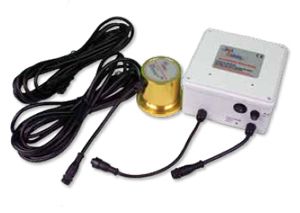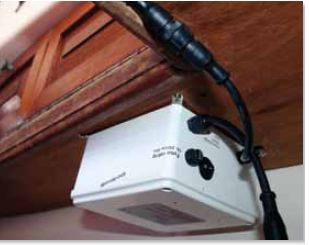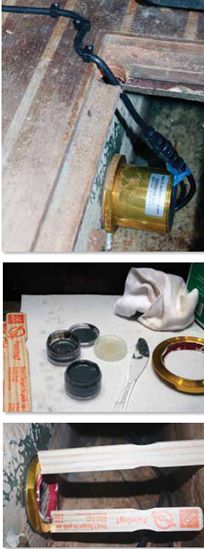
300
Prompted by several reader queries and our own curiosity, Practical Sailor recently launched a test of an electronic alternative to metal-based bottom paints: the M20, an ultrasonic antifouling device from the Canada-based SmartAntifouling.
Electronic antifouling uses ultrasound waves to prevent algae and other organisms from attaching to a boat’s hull. It’s marketed as being more eco-friendly and less expensive than copper bottom paints as there are no chemicals, no waste, and no pollution involved, and there is no regular maintenance required.
It works like this: A transducer, which is mounted on the hull skin inside the boat and is powered by the ship’s battery, emits a high-frequency vibration that creates a cavitation effect under the water. This, according to the M20’s maker, results in a micro-thin layer of rapidly moving water blanketing the hull, making it difficult for barnacles and algae to take up residence on the hull.

309
The Install
We installed SmartAntifouling’s M20-12-2 (for boats shorter than 30 feet) on our Sarasota, Fla.-based 1982 Cape Dory 25 test boat, Skimmer. Having just removed Interlux’s discontinued Pacifica bottom paint (see “Eco-friendly Bottom Paints” on Inside Practical Sailor online) from the hull, we were ready for a fresh start.
While ultrasonic antifouling is intended as an alternative to metal-based bottom paint for fouling protection, users still must “seal” the hull with a coating. The manufacturer recommends using the M20 in conjunction with an antifouling paint for “ultimate protection.” We applied three coats of Sea Hawk’s eco-friendly Smart Solutions (www.seahawkpaints.com) to Skimmer’s hull in preparation for the evaluation because it is compatible with most other bottom paints and because it uses metal-free biocides instead of copper to fight fouling.
Once the hull was painted, it was time to mount the M20. The setup included a transducer, a threaded stainless and alloy mounting ring, a 12-volt control box with mounting screws, two lengths of coax cable (15 feet and 7.5 feet long), and a two-part epoxy for mounting. The installation seemed simple and straightforward enough: Find a mounting spot inside the boat; glue the mounting ring to the hull and screw the transducer into the ring (or glue both the mounting ring and transducer for a more effective and totally permanent installation); mount the power box; and run power cables between the transducer and the control box, and the box and a 12-volt battery. But the fine print is what you really have to pay attention to.
To get the most out of the device, the instructions advise, it’s best to mount the transducer in a spot that is: horizontal, flat, and dry; just aft of midships (each transducer covers a diameter of about 15 feet); at or just below the waterline; and on the outer hull skin where thickness is 1 inch or less (not a bulkhead or rib, or on cored hulls). That ideal spot was nowhere to be found on the CD25—unless we wanted to Sawzall a sizable hole in the liner, which runs stem to stern and from the deck down. Testers nixed any plan to put a permanent hole in the liner for a temporary product test, so we were left with the side of the shallow bilge as our only option for a mounting spot. The vertical surface presented some potential adhesion issues that we addressed by using shims to wedge the ring in place (see photo on page 21), and the tight confines of the tiny bilge made smooth-sanding the surface challenging, but in the end, the paste-like epoxy was easy to apply and effective in creating a secure bond.
The next challenge was ensuring the device had consistent power to run continuously. The M20 draws a half-amp of power, but the small test boat lives on a mooring—with no shore power, inboard engine, or generator to charge the battery—so adding a solar panel was the only option. We added a 15-watt solar panel, which is what the company recommends, to the 5-watt panel already helping power the boat.
All told, the install steps—finding a spot for the unit, cleaning and sanding, epoxying and shimming, mounting the control box under a cabin shelf, running power cables, and hooking up the solar panel—took testers about three hours. The installation was a success, and all was well—until we powered up the M20.

204
‘This is a Test’
With the M20’s indicator lights telling us the device was working properly, it began making a sound reminiscent of those alarm tones used in Emergency Broadcast System tests. We checked connections and reset the device, and when that didn’t silence the noise, we contacted the maker.
SmartAntifouling Chief Operating Officer Bob Habib walked us through a few troubleshooting steps before we concluded that what testers described as a “loud intermittent alarm buzz” coming from the transducer and reverberating through the boat’s liner was what the manufacturer described as “a low chirping sound” the M20 makes when cycling. Habib advised us to slide a neoprene drink holder (can koozie) over the transducer to muffle the noise.
“The sound level varies from boat to boat depending on a variety of factors that influence the energy dissipation,” he explained, attributing the excessive volume in our case to having mounted the transducer in the bilge—our only choice but something we’d recommend others try to avoid.
The koozie fix reduced the “chirp” volume from 70 decibels (reading taken from 3 feet away) to 63 decibels, which is normal conversation level. To achieve the “nearly imperceptible” chirp that the company website describes, we would need to put soundproofing in the bilge, an impractical fix. Instead, we just turn the unit off when sleeping onboard, making VHF calls, and when underway. (You can hear the cycling from the cockpit under sail.) This should not affect its performance. According to SmartAntifouling, it is ideal to run the M20 24 hours a day, but the minimum to keep a hull clean is eight to 12 hours runtime daily.
Performance Results
We plan to long-term test the M20, checking Skimmer’s bottom regularly for soft or hard growth, particularly in the area where the transducer is mounted. Because the bottom is also coated with an antifouling paint—albeit metal free—it will be difficult to determine whether any fouling protection is a result of the M20 or the Smart Solutions. Similar tests we’ve seen reported on by other media have encountered the same challenge. In an effort to get a more accurate idea of how well the M20 performs, testers also will be monitoring another boat that is moored in the same anchorage as the test boat and has Smart Solutions paint on its hull. Both boats had their hulls painted at about the same time; both see the same water and weather conditions; and both are sailed once or twice weekly. Stay tuned for updates.
Bottom line
The hardest part of installing the SmartAntifouling M20 was finding a suitable location for it onboard. The actual steps, outlined clearly in the directions, were easy enough to carry out for any DIYer. However, if you’re considering such a device, be sure to check out the mounting stipulations before buying, and determine ahead of time whether there’s a mounting spot that will enable the device to be effective—and sufficiently quiet.
While the technology—at least in theory—may be more eco-friendly and have fewer maintenance costs than using copper paints, users still must apply and maintain a hull coating. Also, regular hull cleaning will still be necessary—although the maker claims this will only entail wiping soft growth, rather than scraping hard growth.
SmartAntifouling devices aren’t cheap—with prices starting at about $1,200 for the unit we tested—but the cost is comparable to having a 25-foot boat’s bottom painted once with a top-notch copper-laden antifoulant, or twice with a bargain paint. The M20, which comes with a limited one-year warranty, should last for many seasons, but it does have associated costs, like coating the hull and adding solar panels.
As far as the M20’s performance goes, we’re remaining optimistically skeptical. The jury’s still out, but we look forward to seeing how it performs in conjunction with the Sea Hawk Smart Solutions.

































